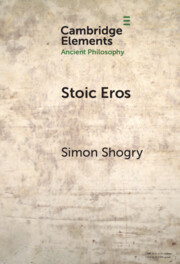Element contents
Stoic Eros
Published online by Cambridge University Press: 24 January 2024
Summary
Information
- Type
- Element
- Information
- Series: Elements in Ancient PhilosophyOnline ISBN: 9781009039277Publisher: Cambridge University PressPrint publication: 15 February 2024
References
Accessibility standard: Unknown
Why this information is here
This section outlines the accessibility features of this content - including support for screen readers, full keyboard navigation and high-contrast display options. This may not be relevant for you.Accessibility Information
- 3
- Cited by
